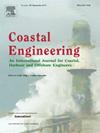岸波监测用波浪浮标三维响应与性能评价
IF 4.5
2区 工程技术
Q1 ENGINEERING, CIVIL
引用次数: 0
摘要
本研究分析了为新的意大利浮标网络设计的大型系泊加速度计波浪浮标的原位三维响应和性能。该浮标被部署在北亚得里亚海海洋塔附近的沿海水域,通过立体成像系统和波浪计对其跟踪波浪运动的能力进行了评估。通过采用一种基于立体视图的新型光学系统,测量了浮标的3D位移(垂直和水平运动),从而深入了解了浮标的动态,并与机载波浪传感器进行了比较。测量结果表明,在0.15-0.60 Hz的窄带范围内,浮标的升沉与波浪高度吻合良好,除了0.52 Hz左右,这是浮标的固有频率。低频和高频下的性能下降归因于传感器处理以及浮标和系泊响应,这可以通过校准浮标起伏的经验响应算子来解决。此外,在水平运动中观察到相位延迟,可能是由浮标惯性引起的。对于波浪统计,虽然浮标有效捕获线性波形,但由于其动态响应,它对二阶非线性效应的敏感性降低,影响了观测最大波浪高程的能力。尽管存在这些限制,浮标数据仍然可以可靠地估计显著波高和平均波向。本研究增强了对系泊浮标动力学的理解,并有助于优化浮标对海岸波浪监测的响应。本文章由计算机程序翻译,如有差异,请以英文原文为准。
Evaluation of the 3D response and performance of an operational wave buoy for coastal wave monitoring
This study analyzes the in situ 3D response and performance of a large, moored, accelerometer-based wave buoy designed for the new Italian buoy network. Deployed in coastal waters near an oceanographic tower in the North Adriatic Sea, the buoy's capability to follow wave motion was evaluated against a stereo-imaging system and a wave gauge. By employing a novel optical system based on stereo view, the 3D buoy displacement (vertical and horizontal motions) was measured, providing insights into buoy dynamics and enabling comparison with the onboard wave sensor. Measurements indicate good agreement between buoy heave and wave elevation in a narrow frequency band of 0.15–0.60 Hz, except around 0.52 Hz, which represents the buoy's natural frequency. Performance degradation at low and high frequencies was attributed to sensor processing as well as buoy and mooring responses, which were addressed by calibrating an empirical response operator for the buoy heave. Furthermore, a phase delay in horizontal motion was observed, likely caused by buoy inertia. For wave statistics, while the buoy effectively captures linear waveforms, it shows reduced sensitivity to second-order nonlinear effects due to its dynamic response, impacting the ability to observe maximum wave elevations. Despite these limitations, buoy data reliably estimate significant wave height and mean wave direction. This study enhances the understanding of moored buoy dynamics and aids in optimising buoy response for coastal wave monitoring.
求助全文
通过发布文献求助,成功后即可免费获取论文全文。
去求助
来源期刊

Coastal Engineering
工程技术-工程:大洋
CiteScore
9.20
自引率
13.60%
发文量
0
审稿时长
3.5 months
期刊介绍:
Coastal Engineering is an international medium for coastal engineers and scientists. Combining practical applications with modern technological and scientific approaches, such as mathematical and numerical modelling, laboratory and field observations and experiments, it publishes fundamental studies as well as case studies on the following aspects of coastal, harbour and offshore engineering: waves, currents and sediment transport; coastal, estuarine and offshore morphology; technical and functional design of coastal and harbour structures; morphological and environmental impact of coastal, harbour and offshore structures.
 求助内容:
求助内容: 应助结果提醒方式:
应助结果提醒方式:


